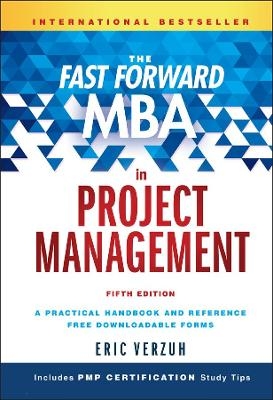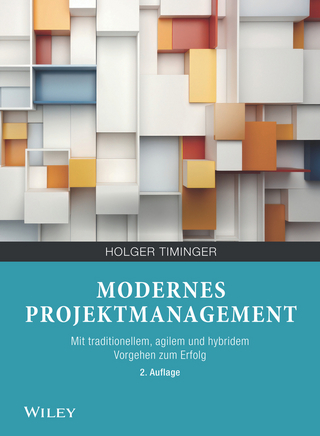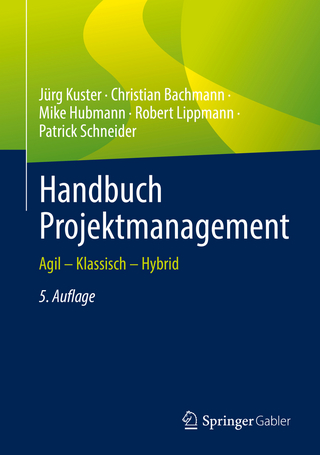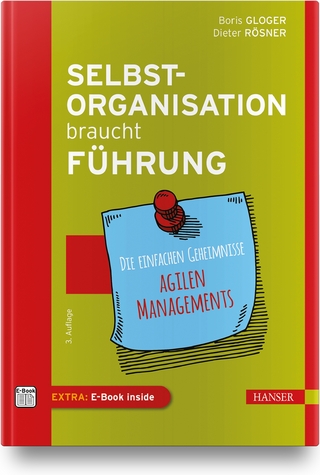
The Fast Forward MBA in Project Management
John Wiley & Sons Inc (Verlag)
978-1-119-14822-7 (ISBN)
The all-inclusive guide to exceptional project management
The Fast Forward MBA in Project Management is the comprehensive guide to real-world project management methods, tools, and techniques. Practical, easy-to-use, and deeply thorough, this book gives you answers you need now. You'll find the cutting-edge ideas and hard-won wisdom of one of the field's leading experts, delivered in short, lively segments that address common management issues. Brief descriptions of important concepts, tips on real-world applications, and compact case studies illustrate the most sought-after skills and the pitfalls you should watch out for. This new fifth edition features new case studies, new information on engaging stakeholders, change management, new guidance on using Agile techniques, and new content that integrates current events and trends in the project management sphere.
Project management is a complex role, with seemingly conflicting demands that must be coordinated into a single, overarching, executable strategy — all within certain time, resource, and budget constraints. This book shows you how to get it all together and get it done, with expert guidance every step of the way.
Navigate complex management issues effectively
Master key concepts and real-world applications
Learn from case studies of today's leading experts
Keep your project on track, on time, and on budget
From finding the right sponsor to clarifying objectives to setting a realistic schedule and budget projection, all across different departments, executive levels, or technical domains, project management incorporates a wide range of competencies. The Fast Forward MBA in Project Management shows you what you need to know, the best way to do it, and what to watch out for along the way.
ERIC VERZUH is President of The Versatile Company, a project management training and consulting firm based in Seattle, Washington. His company trains thousands of professionals every year in the fundamentals of successful project management. Verzuh is a certified Project Management Professional (PMP) by the Project Management Institute and the author of The Portable MBA in Project Management, published by Wiley. Contact him at www.VersatileCompany.com or e-mail him at EVerzuh@VersatileCompany.com.
Forms Available Online xii
Acknowledgments xiii
About the Author xv
Preface xvii
Part 1 Introduction
Chapter 1—Project Management: A Platform for Innovation 2
Introduction 2
Project Management is Keeping Pace with Global Change 4
Project Management is an Essential Leadership Skillset 5
Successful Projects Deliver Value 5
The Art and Science of Project Leadership 6
A Practical Checklist for Successful Projects: How This Book Will Help You 8
Beyond the Book: Tools for Application and Continuous Learning 11
End Point 13
Stellar Performer: OrthoSpot 14
Stellar Performer: PM4NGOs 15
Chapter 2—Foundation Principles of Project Management 17
Introduction 17
Projects Require Project Management 17
The Challenge of Managing Projects 19
The Evolution of a Discipline 20
The Definition of Success 24
Project Management Functions 26
Project Life Cycle 28
Organizing for Projects 31
Project Managers Are Leaders 35
End Point 36
Stellar Performer: Seattle Children’s Hospital and Regional Medical Center 37
Chapter 3—Build Great Products: Lessons from Agile, Lean Start-Up, and Stage-Gate 42
Introduction 42
Defining Value: A New Lens for Judging Projects Informs the Development Process 43
Leverage a Consistent Product Development Process 44
Best Practices for Capturing Requirements Are Integrated into a Product Development Process 47
A Development Process is Not Project Management 48
Innovation Projects Experiment to Discover Desirability and Viability 49
End Point 51
Stellar Performer: The Lean Startup Innovation Movement 53
Stellar Performer: The Agile Approach to Software Development 57
Stellar Performer: The Stage-Gate System for New-Product Development 65
Part 2 Defining the Project
Chapter 4—Project Initiation: Turning a Problem or Opportunity into a Project 74
Introduction 74
Project Initiation’s Place in the Project Life Cycle 75
A Proposal Defines the Future Business Value 77
Managing Requirements is Tightly Linked to Project Initiation 78
Common Principles for Project Initiation 80
Basic Project Proposal Content 85
Designing a Realistic Initiation Process 88
End Point 89
Stellar Performer: The Logical Framework Approach 90
Chapter 5—Know Your Key Stakeholders and Win Their Cooperation 98
Introduction 98
Stakeholder Focus Throughout the Life of the Project 99
Stakeholder Management is Risk Management for People 101
Stakeholder Roles: Project Manager 102
Stakeholder Roles: Project Team 102
Stakeholder Roles: Management 103
Stakeholder Roles: The Customer 106
Affected Stakeholders Can Make Crucial Contributions 108
Engage Affected Stakeholders 110
Lead the Stakeholders 112
End Point 113
Fast Foundation in Project Management 113
Chapter 6—Write the Rules: Key Documents to Manage Expectations and Define Success 116
Introduction 116
Project Rules Are the Foundation 117
Publish a Project Charter 119
Write a Statement of Work 121
Statement of Work: Minimum Content 122
Responsibility Matrix 129
End Point 132
Fast Foundation in Project Management 133
Part 3 The Planning Process
Chapter 7—Risk Management: Minimize the Threats to Your Project 137
Introduction 137
All Project Management is Risk Management 138
The Risk Management Framework 141
Step One: Identify the Risks 142
Step Two: Analyze and Prioritize the Risks 146
Step Three: Develop Response Plans 152
Step Four: Establish Contingency and Reserve 158
Step Five: Continuous Risk Management 159
Unexpected Leadership 160
End Point 160
Fast Foundation in Project Management 161
Chapter 8—Work Breakdown Structure: Break Your Project into Manageable Units of Work 164
Introduction 164
Defining the Work Breakdown Structure 165
Building a Work Breakdown Structure 168
Criteria for a Successful Work Breakdown Structure 172
Work Package Size 175
Planning for Quality 177
Breaking Down Large Programs 179
Contractors or Vendors Can Provide a WBS 180
End Point 180
Chapter 9—Realistic Scheduling 183
Introduction 183
Planning Overview 183
Planning Step Two: Identify Task Relationships 185
Planning Step Three: Estimate Work Packages 189
Planning Step Four: Calculate an Initial Schedule 195
Planning Step Five: Assign and Level Resources 203
Small Projects Need Smaller Plans 213
End Point 214
Fast Foundation in Project Management 214
Chapter 10—Managing Agile Development with Scrum 216
Introduction 216
Scrum is a Framework 217
Managing the Product Backlog 223
Make the Plan Visible: Task Boards and Burndown Charts 225
Key Factors for Scrum to Be Effective 227
End Point 229
Chapter 11—The Art and Science of Accurate Estimating 230
Introduction 230
Estimating Fundamentals 231
Estimating Techniques 237
Building the Detailed Budget Estimate 246
Generating the Cash Flow Schedule 253
End Point 254
Fast Foundation in Project Management 254
Stellar Performer: Tynet, Inc. 255
Stellar Performer: Adobe Systems 258
Chapter 12—Balancing the Trade-Off Among Cost, Schedule, and Quality 264
Introduction 264
Three Levels of Balancing a Project 265
Balancing at the Project Level 266
Balancing at the Business Case Level 278
Balancing at the Enterprise Level 283
End Point 284
Stellar Performer: Safeco Field 285
Stellar Performer: Boeing 767-400ER Program 289
Part 4 Controlling the Project
Chapter 13—Building a High-Performance Project Team 294
Introduction 294
A Framework for Building High-Performance Teams 298
Leadership Responsibilities 302
Building a Positive Team Environment 306
Ground Rules 307
Team Identity 309
Team Listening Skills 313
Meeting Management 317
Summary of Building a Positive Team Environment 317
Collaborative Problem Solving 319
Problem Analysis 319
Decision Modes 321
Conflict Management 326
Continuous Learning 329
Summary of Collaborative Problem Solving 333
Job Satisfaction 333
End Point 334
Stellar Performer: Habitat for Humanity 335
Chapter 14—Clear Communication Among Project Stakeholders 337
Introduction 337
Embrace Your Role as a Leader 338
Creating a Communication Plan 338
Change Management: Promote Behavior Change in Affected Stakeholders 345
Communicating Within the Project Team 353
Stellar Performer: Lockheed Martin Aeronautics 359
Closeout Reporting 361
End Point 362
Fast Foundation in Project Management 363
Chapter 15—Control Scope to Deliver Value 365
Introduction 365
The Change Control Process 366
Configuration Management 372
Change Control is Essential for Managing Expectations 374
End Point 374
Fast Foundation in Project Management 374
Chapter 16—Measuring Progress 376
Introduction 376
Measuring Schedule Performance 376
Measuring Cost Performance 380
Earned Value Reporting 382
Cost and Schedule Baselines 391
End Point 393
Chapter 17—Solving Common Project Problems 396
Introduction 396
Responsibility Beyond Your Authority 396
Disaster Recovery 397
Reducing the Time to Market 398
When the Customer Delays the Project 399
The Impossible Dream 400
Fighting Fires 401
Managing Volunteers 401
End Point 402
Part 5 Advancing Your Practice of Project Management
Chapter 18—Enterprise Project Management: Coordinate All Projects and Project Resources in Your Organization 405
Introduction 405
Defining Enterprise Project Management 407
Three Tiers of Management Within EPM 409
The Four Components of EPM 411
Establish Consistent EPM Processes 412
Technology Enables EPM Processes 415
The People Who Deliver Projects 419
Support Project Management: The Project Office 420
End Point 428
Stellar Performer: Bill & Melinda Gates Foundation: Enterprise Project Management Office 430
Chapter 19—Requirements Engineering: The Key to Building the Right Product 437
James Rivera and Eric Verzuh
Introduction 437
Requirements Engineering and Project Management Are Intimately Connected 438
Requirement Types Illustrate the Evolving Product Vision 439
Requirements Engineering Scope and Processes 441
Requirements Development Activities 443
Requirements Management Activities 445
Requirements Documentation Techniques 447
Requirements Engineering Demands Discipline 447
End Point 449
Chapter 20—Project Portfolio Management: Align Project Resources with Business Strategy 450
Ralph Kliem and Eric Verzuh
Introduction 450
The Scope and Goals of the Portfolio 452
Stakeholders: Roles in Project Portfolio Management 453
PPM Information Supports Decisions 455
Project Selection and Prioritization 456
Ongoing Portfolio Management 459
Monitor the Results of Projects and the Portfolio 460
Culture Change 461
End Point 461
Chapter 21—PMP Exam Preparation 462
Tony Johnson
Introduction 462
Requirements to Earn the PMP 463
Top 10 Study Tips for the PMP Exam 463
End Point 467
Chapter 22—Microsoft Project: Guidelines for Effective Use 468
Introduction 468
Project Management Software Supports
the Discipline 469
Looking Under the Hood: The Design of Project 469
Set Up the Project First 471
Follow the Planning Model in This Book 471
Task Types: Fix the Duration, Work, or Resource Level 473
Assigning Resources to a Project 473
Resource Leveling Your Schedule 476
Maintaining the Plan Throughout the Project 478
Project Server and Project Web App 479
End Point 480
Appendix A: The Detailed Planning Model 481
Appendix B: Downloadable Form Samples 490
Notes 495
Index 497
| Erscheint lt. Verlag | 18.12.2015 |
|---|---|
| Reihe/Serie | The Fast Forward MBA Series |
| Verlagsort | New York |
| Sprache | englisch |
| Maße | 155 x 231 mm |
| Gewicht | 794 g |
| Themenwelt | Wirtschaft ► Betriebswirtschaft / Management ► Projektmanagement |
| ISBN-10 | 1-119-14822-7 / 1119148227 |
| ISBN-13 | 978-1-119-14822-7 / 9781119148227 |
| Zustand | Neuware |
| Haben Sie eine Frage zum Produkt? |
aus dem Bereich


